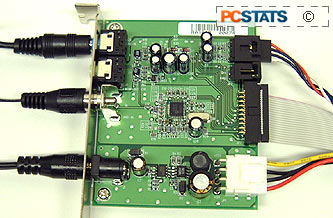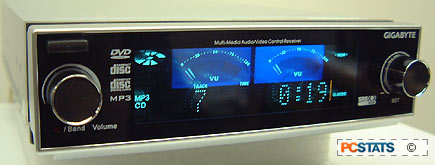 Now,
while there is obviously an IDE port and molex power connector at the back of
the M1600A DVD-ROM, things start go a little differently here than with
other optical drives. The IDE connector still hooks up to the motherboard,
but the molex power connector needs to be connected to the included GM-100
control card which sits in a free bracket above the PCI slots (it doesn't
actually plug into the PCI slot though). For users looking to install the
M1600A DVD-ROM in a small form factor PC, at least one free PCI
slot must to be free.
Now,
while there is obviously an IDE port and molex power connector at the back of
the M1600A DVD-ROM, things start go a little differently here than with
other optical drives. The IDE connector still hooks up to the motherboard,
but the molex power connector needs to be connected to the included GM-100
control card which sits in a free bracket above the PCI slots (it doesn't
actually plug into the PCI slot though). For users looking to install the
M1600A DVD-ROM in a small form factor PC, at least one free PCI
slot must to be free.
The GM-100 control card pictured above does a
couple crucial jobs. First and foremost, it provides the Gigabyte M1600A with
power so that the drive can operate even when the PC is shut down, supporting
the CD, MP3 CD, and radio functions. An AC adaptor plugs into the unit to supply
it with DC voltage.
Through a flat jumper cable, the control card is
supplied with the antenna signal from the rear FM antenna, and audio in/out
channels for external and internal devices. Gigabyte include short jumper cables
for both the analog audio connector (typically found on the rear of CDROMs) and
the headphone jacks on the back of the bracket. This allows the M1600A to
accept an auxiliary audio source, or output its audio through an
existing sound card when the PC is all powered up, or even just a pair
of headphones when the computer is off.
Notes on using the Gigabyte M1600A
Multimedia DVD-ROM
 The
sound quality from the Gigabyte M1600A is pretty good when it comes to MP3s or
CD playback, and even managed to improve on what I expected from a
digital FM tuner. The audio presets (pop, jazz, etc.) help enormously, and
the lack of any noticeable background static or fuzz is definitely a plus.
The
sound quality from the Gigabyte M1600A is pretty good when it comes to MP3s or
CD playback, and even managed to improve on what I expected from a
digital FM tuner. The audio presets (pop, jazz, etc.) help enormously, and
the lack of any noticeable background static or fuzz is definitely a plus.
SRS is an interesting little audio tweak comprising SRS
Trubass, 3D and WOW settings. Listening through a pair of Grado SR-80 headphones
(there is no headphone jack on the M1600A DVD-ROM itself) it was clear that
with SRS turned on, and volume set to higher levels, a small amount of
background 'white noise' seemed to leak in. If dance beats are the tune to
which you rock on, the SRS TruBass will quickly be your new best friend.
Trubass kicks up the bass significantly, and if
that isn't enough to get your party started, the SRS WOW setting allows virtual
front and width adjustments to the sound (called punch and width). The remote
that comes with the Gigabyte M1600A will allow you to change those settings with
the press of a couple buttons, as there are almost too many options to pick
through with the control dial.
 Volume controls work well up to the maximum limit
without any distortion. The volume dial can be a little sensitive, and we found that
if the dial is turned too quickly the M1600A looses resolution on the control and
can't keep up. Turn the volume dial at a steady speed and everything
works great.
Volume controls work well up to the maximum limit
without any distortion. The volume dial can be a little sensitive, and we found that
if the dial is turned too quickly the M1600A looses resolution on the control and
can't keep up. Turn the volume dial at a steady speed and everything
works great.
The remote is a handy way to adjust volume and CD track
controls from a distance, but it is about the size of a credit card and likely
to get lost if you're careless. On the M1600A we tested, the angle the remote
had to be held at for its IrDA signal to be received by the M1600A
was quite shallow, but the manufacturer has made appropriate adjustments to
fix this we are already told.
It might be worth mentioning that while the M1600A
does indeed provide you with radio, CD audio and CD-MP3 audio playback, it is
not a substitute for an existing sound card - it is just a superbly
beefed up 16X DVD-ROM. The Gigabyte M1600A handles audio from the drive just as
a typical CDROM might, so that means all PC-based sounds still need to be
processed by the motherboard or add-on soundcard.
